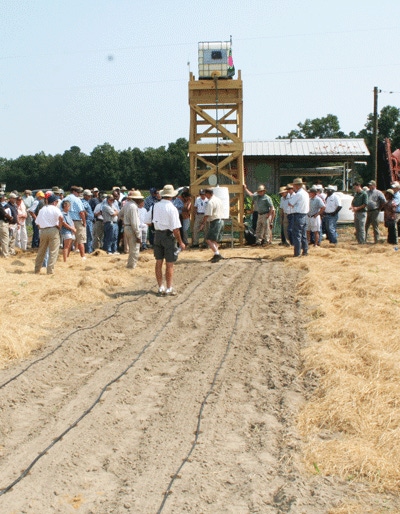
Clemson refines irrigation system
Since electricity isn’t available in rural Afghanistan Clemson University researchers had to develop an irrigation system that could be used without electricity, so they developed a gravity flow system that was first used by Central American Indians well over a thousand years ago.
September 1, 2010

It is simple in design and has been around several centuries, but refinements made to gravity flow irrigation by researchers at Clemson University may help small acreage U.S. farmers and will be a crop saver, if not a life saver for Afghan farmers.
A 16-foot tower and a 400 gallon water tank, adorned with a South Carolina Watermelon Board flag, and a four-foot tower with a smaller tank were used to apply water to a field of watermelons at the Edisto Agricultural Research and Extension Center in Blackville, S.C.
That researchers at the Clemson research facility would be conducting irrigation studies isn’t so unusual. That they began the study and built the irrigation tower to help train a team of National Guardsmen on their way to Afghanistan makes the project a bit unique.
Modern drip irrigation systems used to irrigate vegetable crops in the U.S. require a source of electricity to drive the pumps that move the irrigation water. In Afghanistan, rural electricity isn’t available.
The Clemson researchers had to develop an irrigation system that could be used without electricity, so they developed a gravity flow system that was first used by Central American Indians well over a thousand years ago.
Runs standard drip system
For every 2.3 feet in elevation, one pound per square inch of pressure is gained. The 16-foot tower produces enough water pressure to run a standard drip irrigation system. The four-foot tower only produces enough pressure to run a special drip tape, which is reusable.
To get water to the tower is a challenge. There are two options for sites with no electricity. The first is a solar-powered pump and the second is a peddle pump that is much like a bicycle — both could be used in Afghanistan.
Steve Rimar, who works with John Deere Water and has been a part of the Edisto project since its inception, says the gravity flow system is not really feasible for most U.S. growers, because virtually everyone has access to electricity. However, for small resource farmers, or those in areas where electricity isn’t cost effective, these systems may be valuable where natural elevation changes occur or where runoff from rooftops or other water catchment systems can be easily fed to the gravity flow systems.
Clemson area Extension agent Tony Melton says he helped one farmer in upstate South Carolina build a gravity flow system to irrigate tomatoes. “This farmer couldn’t run a pump because of a lack of water pressure. He had a big tank, and we lifted it up off the ground and got enough elevation to get water to his tomatoes,” Melton says.
In Afghanistan the quarter-acre system being tested at the Edisto Station would be ideal for typical-size vegetable operations. It would take 16 refills of the 400 gallon tank per week to provide an inch of water to the quarter acre field.
In Afghanistan the biggest challenge to growing vegetables is getting water to these crops. Rimar says keeping clean water is a big challenge when using one of these gravity flow systems. The four-foot elevation in particular would require near constant management to keep clean water flowing, he says.
Viable for fruit production
“In Afghanistan, they grow a number of small mixed melons, like cantaloupes and Christmas melons. They used to export melons and had a commercial market to do that prior to the prolonged political wars there,” says Clemson horticulturist Gilbert Miller.
Miller was among a team of Clemson Extension workers who trained the team of National Guard agriculturists who are now in Afghanistan. The potential for this type gravity driven irrigation is viable for fruit production there, Miller adds.
Twelve members of the 64-person unit from the South Carolina Army National Guard received agriculture training prior to deployment. The 12-member agriculture team is officially titled, Afghanistan Agribusiness Development Team. The U.S. military recognized the need for such teams in late 2007. Across Afghanistan, Agriculture Development Teams from more than a dozen states, including Indiana, Tennessee and Texas, have helped Afghan farmers with their agricultural endeavors.
Lt. Col. Frank Rice, a 1987 Clemson agriculture economics graduate and 27-year guardsman, said soldiers are uniquely qualified for this mission because they are farmers and agents at home. The unit hopes to help the Afghans stabilize and increase the economic impact of agriculture in their country.
The guard’s role will be to use what the Afghan farmers have and develop the country’s agribusiness into a more productive industry. “Eighty percent of Afghanistan’s gross domestic product comes from agriculture,” Rice said. “We want to help them with sustainable practices they can continue when we leave.”
e-mail: [email protected]
About the Author(s)
You May Also Like





